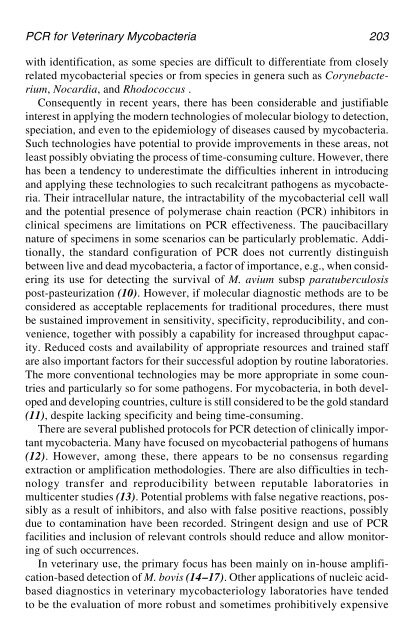PCR Detection of Microbial Pathogens PCR Detection of Microbial ...
PCR Detection of Microbial Pathogens PCR Detection of Microbial ...
PCR Detection of Microbial Pathogens PCR Detection of Microbial ...
Create successful ePaper yourself
Turn your PDF publications into a flip-book with our unique Google optimized e-Paper software.
<strong>PCR</strong> for Veterinary Mycobacteria 203<br />
with identification, as some species are difficult to differentiate from closely<br />
related mycobacterial species or from species in genera such as Corynebacterium,<br />
Nocardia, and Rhodococcus .<br />
Consequently in recent years, there has been considerable and justifiable<br />
interest in applying the modern technologies <strong>of</strong> molecular biology to detection,<br />
speciation, and even to the epidemiology <strong>of</strong> diseases caused by mycobacteria.<br />
Such technologies have potential to provide improvements in these areas, not<br />
least possibly obviating the process <strong>of</strong> time-consuming culture. However, there<br />
has been a tendency to underestimate the difficulties inherent in introducing<br />
and applying these technologies to such recalcitrant pathogens as mycobacteria.<br />
Their intracellular nature, the intractability <strong>of</strong> the mycobacterial cell wall<br />
and the potential presence <strong>of</strong> polymerase chain reaction (<strong>PCR</strong>) inhibitors in<br />
clinical specimens are limitations on <strong>PCR</strong> effectiveness. The paucibacillary<br />
nature <strong>of</strong> specimens in some scenarios can be particularly problematic. Additionally,<br />
the standard configuration <strong>of</strong> <strong>PCR</strong> does not currently distinguish<br />
between live and dead mycobacteria, a factor <strong>of</strong> importance, e.g., when considering<br />
its use for detecting the survival <strong>of</strong> M. avium subsp paratuberculosis<br />
post-pasteurization (10). However, if molecular diagnostic methods are to be<br />
considered as acceptable replacements for traditional procedures, there must<br />
be sustained improvement in sensitivity, specificity, reproducibility, and convenience,<br />
together with possibly a capability for increased throughput capacity.<br />
Reduced costs and availability <strong>of</strong> appropriate resources and trained staff<br />
are also important factors for their successful adoption by routine laboratories.<br />
The more conventional technologies may be more appropriate in some countries<br />
and particularly so for some pathogens. For mycobacteria, in both developed<br />
and developing countries, culture is still considered to be the gold standard<br />
(11), despite lacking specificity and being time-consuming.<br />
There are several published protocols for <strong>PCR</strong> detection <strong>of</strong> clinically important<br />
mycobacteria. Many have focused on mycobacterial pathogens <strong>of</strong> humans<br />
(12). However, among these, there appears to be no consensus regarding<br />
extraction or amplification methodologies. There are also difficulties in technology<br />
transfer and reproducibility between reputable laboratories in<br />
multicenter studies (13). Potential problems with false negative reactions, possibly<br />
as a result <strong>of</strong> inhibitors, and also with false positive reactions, possibly<br />
due to contamination have been recorded. Stringent design and use <strong>of</strong> <strong>PCR</strong><br />
facilities and inclusion <strong>of</strong> relevant controls should reduce and allow monitoring<br />
<strong>of</strong> such occurrences.<br />
In veterinary use, the primary focus has been mainly on in-house amplification-based<br />
detection <strong>of</strong> M. bovis (14–17). Other applications <strong>of</strong> nucleic acidbased<br />
diagnostics in veterinary mycobacteriology laboratories have tended<br />
to be the evaluation <strong>of</strong> more robust and sometimes prohibitively expensive






